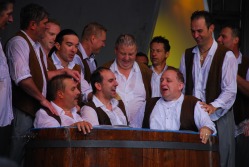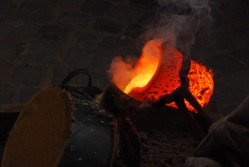
Johannisnacht is a relatively new festival - it's only been held since 1967 - but it reaches back to Mainz's history, especially that of its most famous son, Johannes Gutenberg. After the invention of the printing press, an entire industry sprang up around printing, complete with a printer's guild and the necessary apprentices. Upon completion of their training, the apprentices would be dunked in water in a ceremony known as "Gautschen", which was supposed to "ritualistic cleanse of the impurities they had commited during their time as apprentices" (it would seem that some things never change) - but was really just taken from the old custom of
depostion. Once the apprentices had been dunked, they received a certificate confiming that they had gone through the process to ensure that they wouldn't have to repeat it. When the traditional methods of printing books started to fall by the wayside, the "Gautschen" went with it - until Johannisfest was started. The
Gautschen serves as one of the festival's high points, and the organizers take great pains to make it seem "authentic" - from the man dressed in period costume reading the names off the list to the certificates given out to the dunkees at the end of the day.
Interestingly, the term "apprentices" has adapted to the changing times and now includes those who complete an apprenticeship in any form of media - from newspapers to radio to television. In a gratuitously crowd-pleasing addition, any teacher found in the audience will be hauled up on stage and ceremoniously dunked in the bucket. This ceremony used to be one of many different events - but in 2005 they scrapped the jousting competition that they held in the middle of the Rhine. Other than these main events, the festivalis a fairly typical German city festival, sort of like what
Oktoberfest used to be. One high point is the overly amazing used book fair - I could have spent way more time there looking through all that they had to offer - from antique maps showing Hannibal's march over the Alps to an 1850's printing of Plato's
Phaedrus for Greek students to good, cheap copies of classic German novels. If the books got to be too much, you could recuperate with the dozens of wine stands and listen to cover bands playing classic rock (ZZ Top, Deep Purple, and a great Led Zepplin cover).

In addition to rides, food and drink stands, and stalls hawking a rather odd variety of wares (everything from old advertisement placards to African folk art) there was a surprising exhibition set up in front of the Gutenberg Museum - a delegation from a traditional printing workshop in South Korea set up an interactive display where you could make paper, use traditional printing methods to print Korean characters onto these pages, and then try your hand at traditional book-binding techniques to turn the finished product into a book. And if all that weren't enough, the craftsmen also held regular demonstrations where they would cast the printing blocks out of molten lead - I was amazed at how quickly they were able to produce new characters (it took about 15 minutes to make 8 new ones). It was a very interesting exhibit, and helped to ground the book-printing process somewhere in reality for me. It's all too easy to forget just how much work goes into printing a book and especially to lose touch with it's rich history and traditions - and reconnecting with that process is what Johannisfest (at least partly) is supposed to be about.


 RSS Feed
RSS Feed